Integrating Nature-Based Solutions into Circular Economy Practices: A Case Study on Achieving Net-Zero Emissions at the Asian Institute of Technology
Abstract
1. Introduction
2. Materials and Methods
2.1. Description of the Study Site
2.2. Estimation of the Baseline Emission Levels at the AIT Campus
2.3. Carbon Stocks and Removals from Improved Urban Forest Management, Forest Restoration, and Soil Carbon Biochar
2.3.1. Improved Urban Forest Management
2.3.2. Forest Restoration: Fast-Growing Species, Bamboo Species, and Slow-Growing Species
| Species | MAI Range (m3 ha−1 year−1) | Location | References | |
|---|---|---|---|---|
| Min | Max | |||
| Acacia mangium | 19.0 | 24.0 | S. and S.E. Asia | [41] |
| Gmelina aborea | 10.0 | 15.0 | Africa and Asia | [42] |
| Average | 14.5 | 19.5 | ||
| The assumption for FPFs for this study: 17.0 m3 ha−1 year−1 | ||||
| Dendrocalamus latiflorus Munro | 9.87 | Taiwan | [43] | |
| The assumption for bamboo for this study: 9.8 m3 ha−1 year−1 | ||||
| Tectona grandis | 4.0 | 17.3 | S. and S.E. Asia | [41] |
| Swietenia macrophylla | 7.0 | 10 | Africa and Asia | [42] |
| Average | 5.5 | 13.7 | ||
| The assumption for SPFs for this study: 9.6 m3 ha−1 year−1 | ||||
2.3.3. Models for Predicting Carbon Stocks and Removals
2.3.4. Soil Carbon Biochar
2.3.5. Biochar and Timber Production
2.4. Carbon Balance
3. Results and Discussion
3.1. Baseline Emission Levels at the AIT Campus
3.2. Carbon Stocks and Removals from Improved Urban Forest Management, Forest Restoration, and Soil Carbon Biochar
3.3. Net-Zero: Carbon Emissions, Removals, and Net Emissions
4. Policy Implications
4.1. Strategic Implications for Net-Zero Goals
4.2. Financial Feasibility and Policy Support
4.3. Environmental Education Aspect
5. Conclusions
Author Contributions
Funding
Data Availability Statement
Conflicts of Interest
Abbreviations
| IUFM | Improved Urban Forest Management |
| FPFs | Fast-Growing Species |
| BPFs | Bamboo Species |
| SPFs | Slow-Growing Species |
| Mg | Megagram: 1 Mg is equivalent to 1 ton (t) |
| AIT | The Asian Institute of Technology |
References
- Intergovernmental Panel on Climate Change (IPCC) (Ed.) Climate Change 2022—Mitigation of Climate Change: Working Group III Contribution to the Sixth Assessment Report of the Intergovernmental Panel on Climate Change; Cambridge University Press: Cambridge, UK, 2023; pp. 149–150. [Google Scholar] [CrossRef]
- United Nations Environment Programme. Emissions Gap Report 2023: Broken Record—Temperatures Hit New Highs, Yet World Fails to Cut Emissions (Again); UNEP: Nairobi, Kenya, 2023. [Google Scholar] [CrossRef]
- United Nations. The United Nations Decade on Ecosystem Restoration; United Nations: New York, NY, USA, 2021; Available online: https://wedocs.unep.org/bitstream/handle/20.500.11822/31813/ERDStrat.pdf?sequence=1&isAllowed=y (accessed on 15 May 2024).
- United Nations. The Sustainable Development Goals Report 2023: Special Edition; United Nations: New York, NY, USA, 2023; Available online: https://unstats.un.org/sdgs/report/2023/ (accessed on 15 May 2024).
- DGB Group N.V. Carbon Removal: Nature-Based Solutions for Companies; DGB Group N.V.: Lelystad, The Netherlands, 2023; Available online: https://www.green.earth/blog/carbon-removal-nature-based-solutions-for-companies (accessed on 6 February 2023).
- Sasaki, N.; Myint, Y.Y.; Abe, I.; Venkatappa, M. Predicting carbon emissions, emissions reductions, and carbon removal due to deforestation and plantation forests in Southeast Asia. J. Clean. Prod. 2021, 312, 127728. [Google Scholar] [CrossRef]
- Lefebvre, D.; Williams, A.; Meersmans, J.; Kirk, G.J.; Sohi, S.; Goglio, P.; Smith, P. Modelling the potential for soil carbon sequestration using biochar from sugarcane residues in Brazil. Sci. Rep. 2020, 10, 19479. [Google Scholar] [CrossRef] [PubMed]
- Geissdoerfer, M.; Savaget, P.; Bocken, N.M.P.; Hultink, E.J. The Circular Economy—A new sustainability paradigm? J. Clean. Prod. 2017, 143, 757–768. [Google Scholar] [CrossRef]
- Kirchherr, J.; Reike, D.; Hekkert, M. Conceptualizing the circular economy: An analysis of 114 definitions. Resour. Conserv. Recycl. 2018, 127, 221–232. [Google Scholar] [CrossRef]
- Stahel, W.R. The Circular Economy: A User’s Guide; Routledge: London, UK, 2019. [Google Scholar]
- Sasaki, N. Timber production and carbon emission reductions through improved forest management and substitution of fossil fuels with wood biomass. Resour. Conserv. Recycl. 2021, 173, 105737. [Google Scholar] [CrossRef]
- Kiehle, J.; Kopsakangas-Savolainen, M.; Hilli, M.; Pongrácz, E. Carbon footprint at institutions of higher education: The case of the University of Oulu. J. Environ. Manag. 2023, 329, 117056. [Google Scholar] [CrossRef] [PubMed]
- Valls-Val, K.; Bovea, M.D. Carbon footprint in higher education institutions: A literature review and prospects for future research. Clean Technol. Environ. Policy 2021, 23, 2523–2542. [Google Scholar] [CrossRef]
- Li, D.; Mu, H.; Gao, Y.; Lu, M.; Liu, C. A GIS-based analysis of the carbon-oxygen balance of urban forests in the southern mountainous area of Jinan, China. Sustainability 2022, 14, 16135. [Google Scholar] [CrossRef]
- Sommeechai, M.; Wachrinrat, C.; Dell, B.; Thangtam, N.; Srichaichana, J. Ecological structure of a tropical urban forest in the Bang Kachao Peninsula, Bangkok. Forests 2018, 9, 36. [Google Scholar] [CrossRef]
- O’Flynn, C.; Seymour, V.; Crawshaw, J.; Parrott, T.; Reeby, C.; Silva, S.R.P. The road to net zero: A case study of innovative technologies and policy changes used at a medium-sized university to achieve zero by 2030. Sustainability 2021, 13, 9954. [Google Scholar] [CrossRef]
- Wang, L.; Yan, X.; Fang, M.; Song, H.; Hu, J. A systematic design framework for zero carbon campuses: Investigating the Shanghai Jiao Tong University Fahua Campus case. Sustainability 2023, 15, 7975. [Google Scholar] [CrossRef]
- RtZ Campaign Team; RtZ Partners. Race to Zero 2023 Progress Report; UN Climate Change High-Level Champions; United Nations Framework Convention on Climate Change: Bonn, Germany, 2023; Available online: https://climatechampions.unfccc.int/system/race-to-zero/ (accessed on 15 May 2024).
- Office of Natural Resources and Environmental Policy and Planning, Ministry of Natural Resources and Environment. Long-Term Low Greenhouse Gas Emission Development Strategy (Revised Version); Office of Natural Resources and Environmental Policy and Planning: Bangkok, Thailand, 2022. [Google Scholar]
- Lozano, R.; Ceulemans, K.; Seatter, C.S. Teaching sustainability in European higher education institutions: Assessing the connections between competences and pedagogical approaches. Sustainability 2020, 11, 1602. [Google Scholar] [CrossRef]
- Leal Filho, W.; Shiel, C.; Paço, A. Integrative approaches to environmental education: An overview of university initiatives in sustainability. J. Clean. Prod. 2021, 312, 127382. [Google Scholar] [CrossRef]
- Barth, M.; Rieckmann, M. Developing key competencies in sustainability through environmental education. Int. J. Sustain. High. Educ. 2016, 17, 487–505. [Google Scholar] [CrossRef]
- Song, Y.; Aryal, J.; Tan, L.; Jin, L.; Gao, Z.; Wang, Y. Comparison of changes in vegetation and land cover types between Shenzhen and Bangkok. Land Degrad. Dev. 2020, 32, 1192–1204. [Google Scholar] [CrossRef]
- World Resources Institute (WRI); World Business Council for Sustainable Development (WBCSD). Technical Guidance for Calculating Scope 3 Emissions: Supplement to the Corporate Value Chain (Scope 3) Accounting & Reporting Standard; WRI: Washington, DC, USA; WBCSD: Geneva, Switzerland, 2013. [Google Scholar]
- World Resources Institute (WRI); World Business Council for Sustainable Development (WBCSD). The Greenhouse Gas Protocol: A Corporate Accounting and Reporting Standard; WRI: Washington, DC, USA; WBCSD: Geneva, Switzerland, 2004. [Google Scholar]
- Thailand Greenhouse Gas Management Organization. Emission Factor; Thailand Greenhouse Gas Management Organization: Bangkok, Thailand, 2022; Available online: https://bit.ly/4aF5ut0 (accessed on 6 February 2023).
- myclimate. Calculation Principles—Flight Emissions Calculator; myclimate: Zürich, Switzerland, 2023; Available online: https://www.myclimate.org/en/information/about-myclimate/downloads/flight-emission-calculator/ (accessed on 17 February 2023).
- Klein, D.; Höllerl, S.; Blaschke, M.; Schulz, C. The contribution of managed and unmanaged forests to climate change mitigation—A model approach at stand level for the main tree species in Bavaria. Forests 2013, 4, 43–69. [Google Scholar] [CrossRef]
- Lewis, S.L.; Lopez-Gonzalez, G.; Sonké, B.; Affum-Baffoe, K.; Baker, T.R.; Ojo, L.O.; Wöll, H. Increasing carbon storage in intact African tropical forests. Nature 2009, 457, 1003–1006. [Google Scholar] [CrossRef]
- Brown, S. Estimating Biomass and Biomass Change of Tropical Forests: A Primer; FAO Forestry Paper 134; Food and Agriculture Organization: Rome, Italy, 1997. [Google Scholar]
- Chave, J.; Andalo, C.; Brown, S.; Cairns, M.A.; Chambers, J.Q.; Eamus, D.; Yamakura, T. Tree allometry and improved estimation of carbon stocks and balance in tropical forests. Oecologia 2005, 145, 87–99. [Google Scholar] [CrossRef]
- Huy, B.; Poudel, K.P.; Kralicek, K.; Hung, N.D.; Khoa, P.V.; Phuong, V.T.; Temesgen, H. Allometric equations for estimating tree aboveground biomass in tropical dipterocarp forests of Vietnam. Forests 2016, 7, 180. [Google Scholar] [CrossRef]
- Reyes, G.; Brown, S.; Chapman, J.; Lugo, A.E. Wood Densities of Tropical Tree Species: General Technical Report SO-88; Forest Service Southern Forest Station, United States Department of Agriculture: New Orleans, LA, USA, 1992. [Google Scholar]
- Sands, R. Forestry in a Global Context; CABI: Wallingford, UK, 2013. [Google Scholar] [CrossRef]
- Kim Phat, N.; Knorr, W.; Kim, S. Appropriate measures for conservation of terrestrial carbon stocks—Analysis of trends of forest management in Southeast Asia. For. Ecol. Manag. 2004, 191, 283–299. [Google Scholar] [CrossRef]
- Christian, C.; Pye-Smith, C. Fast-Wood Forestry: Myths and Realities; CIFOR: Bogor Barat, Indonesia, 2003. [Google Scholar]
- Pandey, D.; Brown, C. Teak: A global overview. UNASYLVA-FAO 2000, 3, 3–13. [Google Scholar] [CrossRef]
- Chayaporn, P.; Sasaki, N.; Venkatappa, M.; Abe, I. Assessment of the overall carbon storage in a teak plantation in Kanchanaburi Province, Thailand—Implications for carbon-based incentives. Clean Environ. Syst. 2021, 2, 100023. [Google Scholar] [CrossRef]
- Khun, V.; Sasaki, N. Re-assessment of forest carbon balance in Southeast Asia: Policy implications for REDD+. Low Carbon Econ. 2014, 5, 153. [Google Scholar] [CrossRef]
- IPCC. IPCC Guidelines for National Greenhouse Gas Inventories; Eggleston, H.S., Ed.; National Greenhouse Gas Inventories Programme, IGES: Hayama, Japan, 2006. [Google Scholar]
- FAO. Global Planted Forest Thematic Study: Results and Analysis; Del Lungo, A., Ball, J., Carle, L., Eds.; Planted Forests and Trees Working Paper 38; FAO: Rome, Italy, 2006. [Google Scholar]
- FAO. Planted Forest Database: Analysis of Annual Planting Trends and Silvicultural Parameters for Commonly Planted Species; Del Lungo, A., Ed.; Planted Forests and Trees Working Papers, Working Paper 26; Forest Resources Development Service, Forest Resources Division, FAO: Rome, Italy, 2003. [Google Scholar]
- Yen, T.M.; Sun, P.K.; Li, L.E. Predicting aboveground biomass and carbon storage for Ma bamboo (Dendrocalamus latiflorus Munro) plantations. Forests 2023, 14, 854. [Google Scholar] [CrossRef]
- Banuwa, I.S.; Utomo, M.; Yusnaini, S.; Riniarti, M.; Sanjaya, P.; Suroso, E.; Hidayat, W. Estimation of the above- and below-ground carbon stocks in University of Lampung, Indonesia. Biodiversitas J. Biol. Divers. 2019, 20, 676–681. [Google Scholar] [CrossRef]
- Helen, J.M.; Gasparatos, A. Land use change, carbon stocks, and tree species diversity in green spaces of a secondary city in Myanmar, Pyin Oo Lwin. PLoS ONE 2019, 14, e0225331. [Google Scholar] [CrossRef]
- Narang, V. Managing University Campus Forest for Climate Change Mitigation: A Case Study of the AIT Campus. Master’s Thesis, Asian Institute of Technology (AIT), Pathum Thani, Thailand, 2017. [Google Scholar]
- Liu, Y.H.; Yen, T.M. Assessing aboveground carbon storage capacity in bamboo plantations with various species related to its affecting factors across Taiwan. For. Ecol. Manag. 2021, 481, 118745. [Google Scholar] [CrossRef]
- Amoah, M.; Assan, F.; Dadzie, P.K. Aboveground biomass, carbon storage, and fuel values of Bambusa vulgaris, Oxynanteria abyssinica, and Bambusa vulgaris var. vitata plantations in the Bobiri Forest Reserve of Ghana. J. Sustain. For. 2020, 39, 113–136. [Google Scholar] [CrossRef]
- Devi, A.S.; Singh, K.S. Carbon storage and sequestration potential in aboveground biomass of bamboos in Northeast India. Sci. Rep. 2021, 11, 837. [Google Scholar] [CrossRef]
- Sohel, M.S.I.; Alamgir, M.; Akhter, S.; Rahman, M. Carbon storage in a bamboo (Bambusa vulgaris) plantation in the degraded tropical forests: Implications for policy development. Land Use Policy 2015, 49, 142–151. [Google Scholar] [CrossRef]
- Zheng, X.; Lin, S.; Fu, H.; Wan, Y.; Ding, Y. The bamboo flowering cycle sheds light on flowering diversity. Front. Plant Sci. 2020, 11, 381. [Google Scholar] [CrossRef] [PubMed]
- Kaosa-ard, A. Overview of Problems in Teak Plantation Establishment; RAP Publication (FAO): Bangkok, Thailand, 1998; Available online: https://www.fao.org/3/ac773e/ac773e08.htm#TopOfPage (accessed on 5 February 2023).
- Gourlay, I.D. Growth ring characteristics of some African Acacia species. J. Trop. Ecol. 1995, 11, 121–140. [Google Scholar] [CrossRef]
- Lugato, E.; Bampa, F.; Panagos, P.; Montanarella, L.; Jones, A. Potential carbon sequestration of European arable soils estimated by modelling a comprehensive set of management practices. Glob. Change Biol. 2014, 20, 3557–3567. [Google Scholar] [CrossRef] [PubMed]
- Kavindi, G.A.G.; Tang, L.; Sasaki, Y. Assessing GHG emission reduction in biomass-derived biochar production via slow pyrolysis: A cradle-to-gate LCA approach. Resour. Conserv. Recycl. 2025, 212, 107900. [Google Scholar] [CrossRef]
- Hornung, A.; Stenzel, F.; Grunwald, J. Biochar—Just a black matter is not enough. Biomass Convers. Biorefin. 2024, 14, 5889–5900. [Google Scholar] [CrossRef]
- Henry, M.; Besnard, A.; Asante, W.A.; Eshun, J.; Adu-Bredu, S.; Valentini, R.; Saint-André, L. Wood density, phytomass variations within and among trees, and allometric equations in a tropical rainforest of Africa. For. Ecol. Manag. 2010, 260, 1375–1388. [Google Scholar] [CrossRef]
- Kim, J.E.; Bhatia, S.K.; Song, H.J.; Yoo, E.; Jeon, H.J.; Yoon, J.Y.; Choi, Y.K. Adsorptive removal of tetracycline from aqueous solution by maple leaf-derived biochar. Bioresour. Technol. 2020, 306, 123092. [Google Scholar] [CrossRef] [PubMed]
- Ahmed, A.; Bakar, M.S.A.; Azad, A.K.; Sukri, R.S.; Phusunti, N. Intermediate pyrolysis of Acacia cincinnata and Acacia holosericea species for bio-oil and biochar production. Energy Convers. Manag. 2018, 176, 393–408. [Google Scholar] [CrossRef]
- Gupta, G.K.; Mondal, M.K. Bio-energy generation from Sagwan sawdust via pyrolysis: Product distributions, characterizations, and optimization using response surface methodology. Energy 2019, 170, 423–437. [Google Scholar] [CrossRef]
- Sahoo, S.S.; Vijay, V.K.; Chandra, R.; Kumar, H. Production and characterization of biochar produced from slow pyrolysis of pigeon pea stalk and bamboo. Clean. Eng. Technol. 2021, 3, 100101. [Google Scholar] [CrossRef]
- Aina, O. Wood waste utilization for energy generation. In Proceedings of the International Conference on Renewable Energy for Developing Countries, Forestry, Bangkok, Thailand, 21–23 November 2006. [Google Scholar]
- Etoh, H.; Sasaki, N.; Chay, S.; Ninomiya, H. Carbon emission reduction potentials through thinned wood in Japan. Iforest-Biogeosciences For. 2011, 4, 107. [Google Scholar] [CrossRef]
- Ridhosari, B.; Rahman, A. Carbon footprint assessment at Universitas Pertamina from the scope of electricity, transportation, and waste generation: Toward a green campus and promotion of environmental sustainability. J. Clean. Prod. 2020, 246, 119172. [Google Scholar] [CrossRef]
- Singkran, N. Carbon sink capacity of public parks and carbon sequestration efficiency improvements in a dense urban landscape. Environ. Monit. Assess. 2022, 194, 750. [Google Scholar] [CrossRef] [PubMed]
- Febiriyanti, A.; Pradana, D.H.; Putrika, A. Estimation of carbon stocks from tree stands vegetation in Universitas Indonesia’s urban forest, Depok. J. Phys. Conf. Ser. 2021, 1725, 012043. [Google Scholar] [CrossRef]
- Yin, J.; Zhao, L.; Xu, X.; Li, D.; Qiu, H.; Cao, X. Evaluation of long-term carbon sequestration of biochar in soil with biogeochemical field model. Sci. Total Environ. 2022, 822, 153576. [Google Scholar] [CrossRef]
- Xiao, L.; Feng, L.; Yuan, G.; Wei, J. Low-cost field production of biochars and their properties. Environ. Geochem. Health 2020, 42, 1569–1578. [Google Scholar] [CrossRef]
- Carbon Credits. Carbon Prices Today; Carbon Credits: Broadway, NY, USA, 2024; Available online: https://carboncredits.com/carbon-prices-today/ (accessed on 10 May 2024).
- Ecosystem Marketplace. New State of the Voluntary Carbon Markets 2023 Finds VCM Demand Concentrating Around Pricier High Integrity Credits; Ecosystem Marketplace: Washington, DC, USA, 2023; Available online: https://www.ecosystemmarketplace.com/articles/new-state-of-the-voluntary-carbon-markets-2023-finds-vcm-demand-concentrating-around-pricier-high-integrity-credits/ (accessed on 10 May 2024).

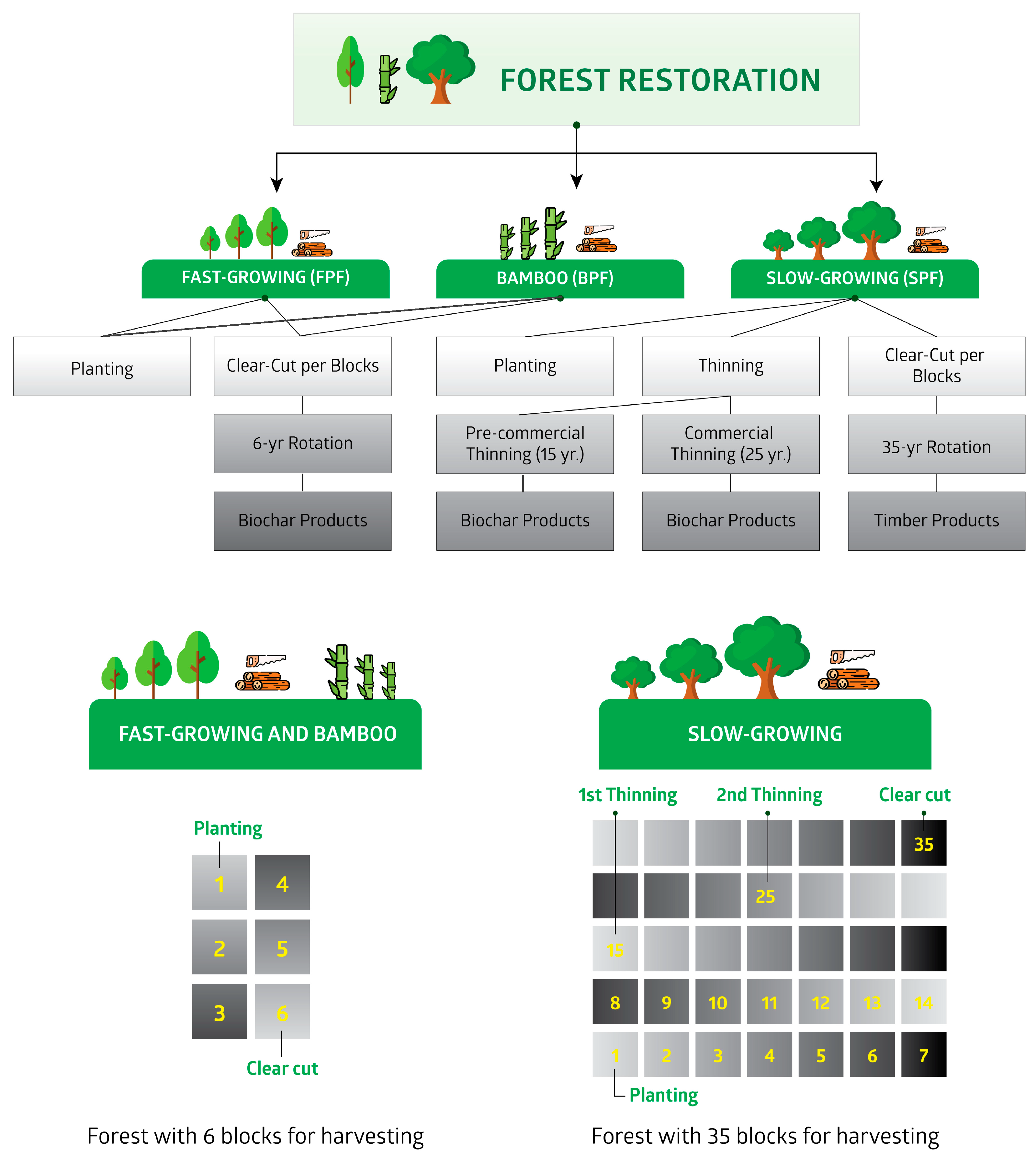

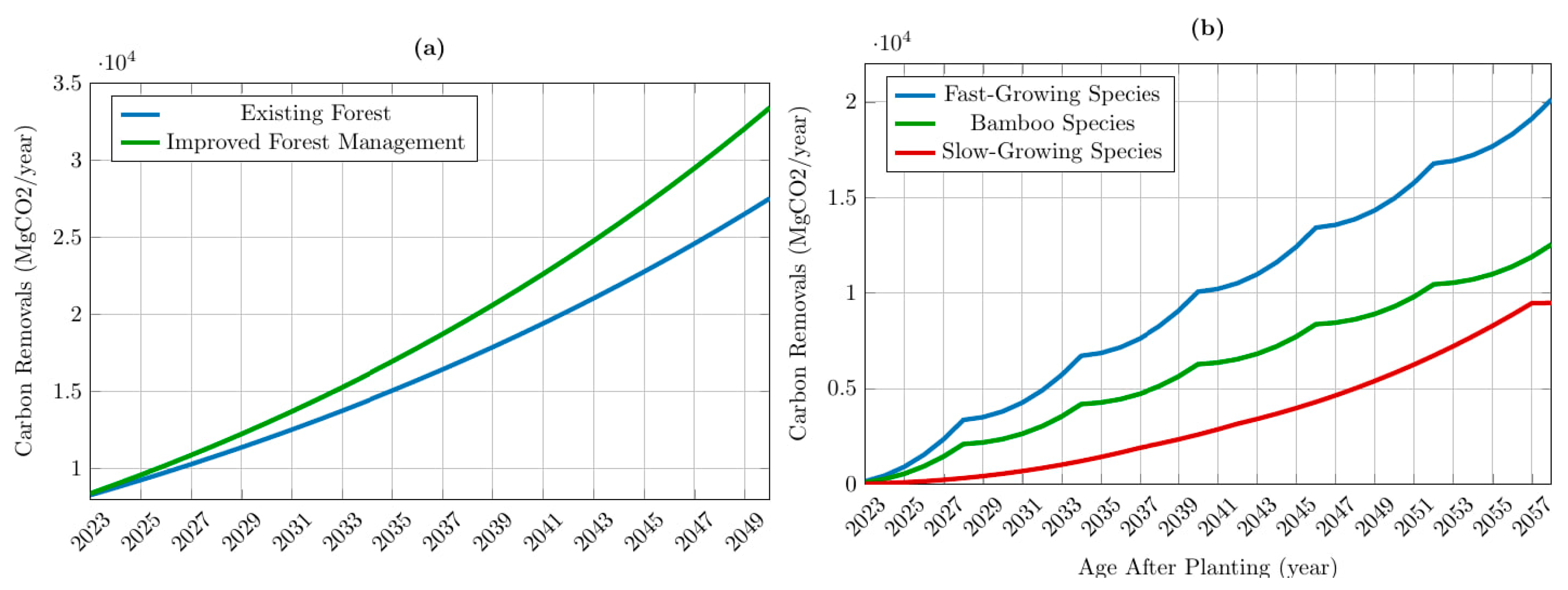
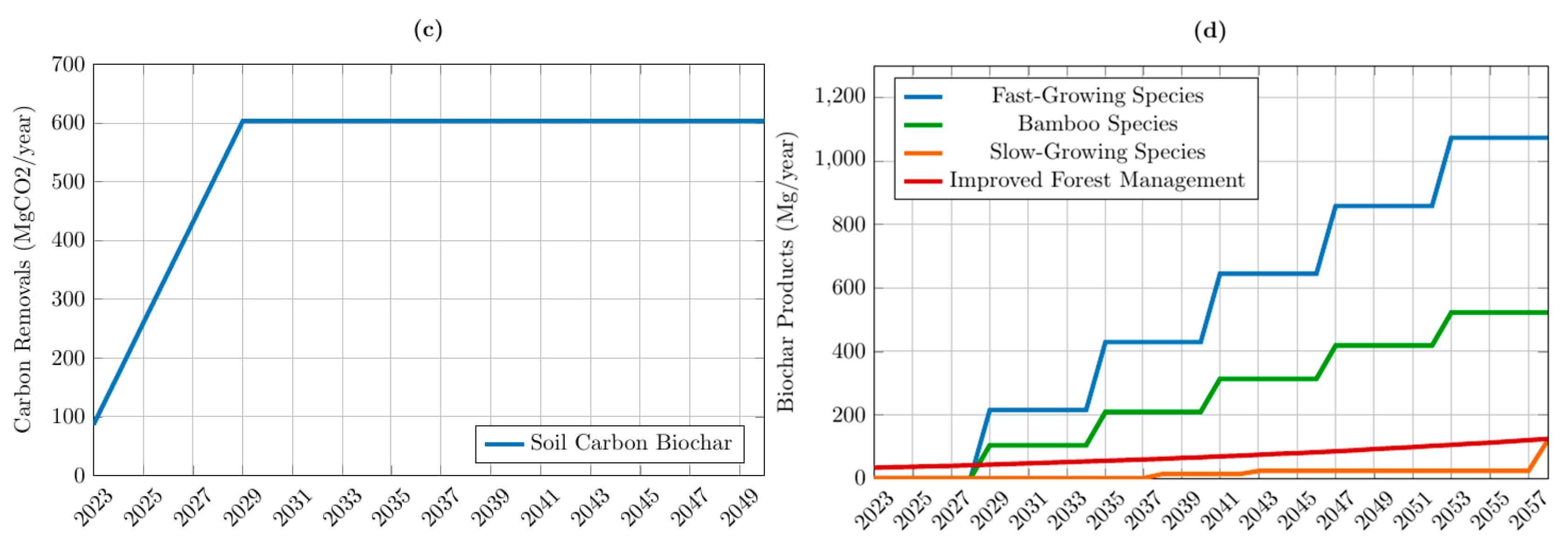
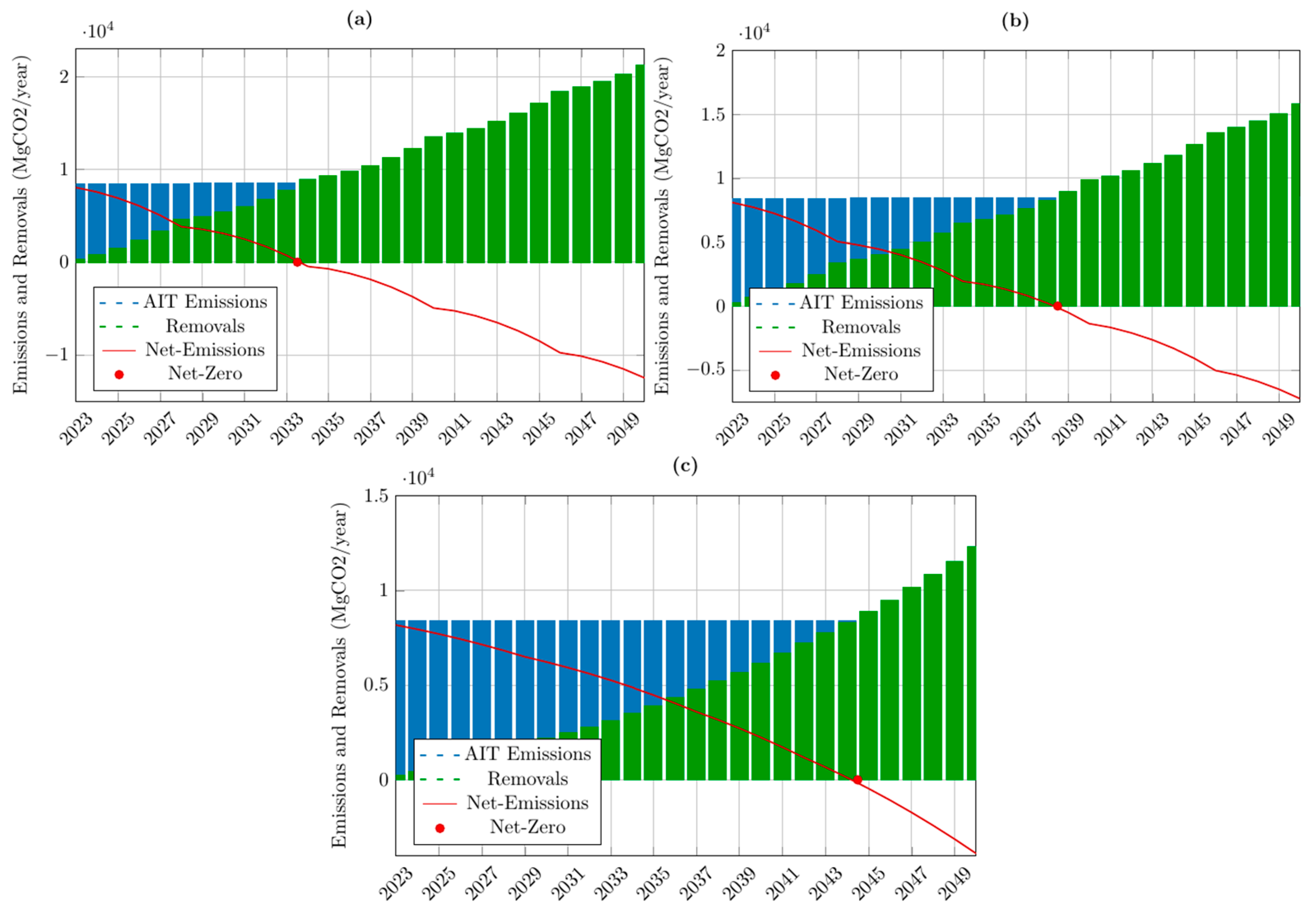
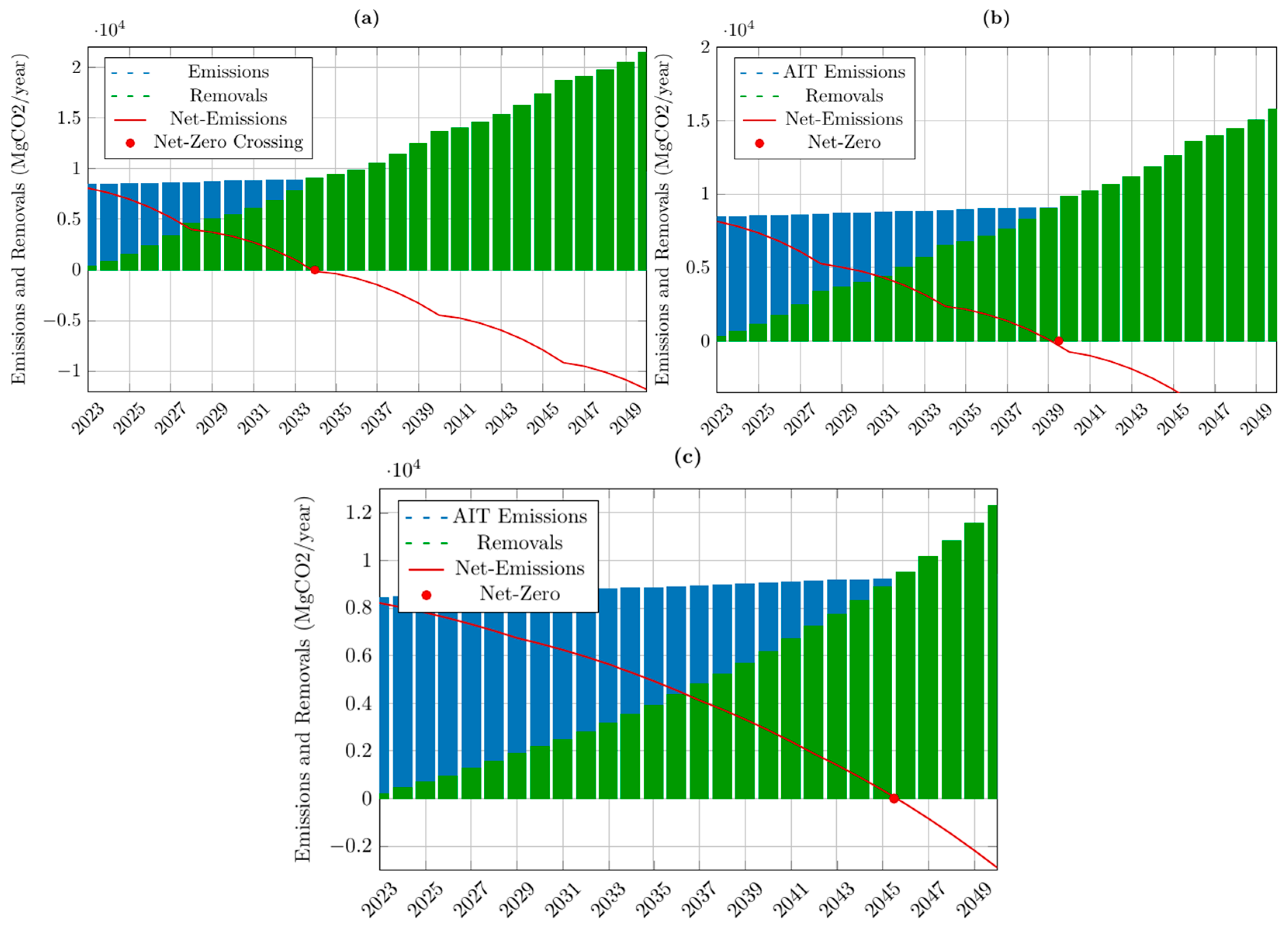
| Description | 2022 Quantity | Emission Factor | Emission Reference |
|---|---|---|---|
| Scope 1 | |||
| Gasohol/AIT vehicles | 17,680.85 (Ltr) | 2.7406 (kgCO2e/Ltr) | [26] |
| Diesel | 186.6 (kg) | 1760 (kgCO2e/kg) | |
| R-22/Air conditioners a | 40.8 (kg) | 1300 (kgCO2e/kg) | |
| R-134a/Chiller a | 695 (Ltr) | 1.7306 (kgCO2e/Ltr) | |
| LPG residence | 14,234.08 (Ltr) | 2.1894 (kgCO2e/Ltr) | |
| Scope 2 | |||
| Electricity/campus consumption | 10,184,128 kWh | 0.4999 (kgCO2e/kWh) | |
| Scope 3 | |||
| Wet wastes | 65,474 (kg) | 2.53 (kgCO2e/kg) | |
| Dry wastes/landfill | 266,687 (kg) | 0.30 (kgCO2e/kg) | |
| Wastewater | 155,887 (m3) | 0.09 (kgCO2e/m3) | |
| Paper | 317,400 (kg) | 2.93 (kgCO2e/kg) | |
| PWA water b | 45,329 (m3) | 0.54 (kgCO2e/m3) | |
| Official air travel c | 728,285.66 (km) | ||
| Official road travel to other provinces d | 35,973.95 (km) | ||
| Community commuting e | |||
| Procurement f |
| Year | New and Continuing Students | Faculty | Research and Support Staff | Total |
|---|---|---|---|---|
| 2008 | 2289 | 123 | 586 | 2998 |
| 2009 | 2364 | 123 | 586 | 3073 |
| 2010 | 2239 | 181 | 586 | 3006 |
| 2011 | 2148 | 173 | 586 | 2907 |
| 2012 | 2071 | 149 | 586 | 2806 |
| 2013 | 1797 | 171 | 586 | 2554 |
| 2014 | 2239 | 306 | 586 | 3131 |
| 2015 | 2216 | 274 | 586 | 3076 |
| 2016 | 2192 | 166 | 586 | 2944 |
| 2017 | 2099 | 147 | 586 | 2832 |
| 2018 | 1914 | 150 | 586 | 2650 |
| 2019 | 1735 | 130 | 586 | 2451 |
| 2020 | 2063 | 122 | 586 | 2771 |
| 2021 | 2939 | 127 | 586 | 3652 |
| 2022 | 2473 | 127 | 586 | 3186 |
| Intervention | Description | Land Availability |
|---|---|---|
| Improved Urban Forest Management | Maintains the campus forest to increase carbon stocks, involving activities like watering, fertilization, pest control, pruning, replanting, and the removal of potential danger from aging trees [28]. | 20 ha |
| Forest Restoration | Restores the campus landscape by planting new trees, considering the following three scenarios: fast-growing species, bamboo species, and slow-growing species, aiming to gain more carbon stocks [6]. | 30 ha |
| Biochar Application | Applies biochar made from wood residues to soil to capture carbon and improve the soil fertility, aiming to increase soil carbon biochar [7]. | 70 ha |
| Symbols | Description |
|---|---|
| Initial carbon stocks (112.9 MgC ha− 1) of the existing forest (aboveground only) (author’s own calculation using the DBH and height from the forest inventory of 1231 trees). | |
| Initial carbon stocks (1.5 MgC ha−1 yr−1) of the improved urban forest management (aboveground only) [29]. | |
| Initial carbon stocks (7.9 MgC ha−1 yr−1) of restoration with fast-growing species (aboveground only) [(7.9 = 17 m3 × 0.57 Mg m−3 × 0.47 MgC Mg−1 × 1.74), where 17 m3 is average MAI of Acacia mangium and Gmelina aborea [41,42], 0.57 is the average wood density tropical tree species [26], 0.47 is the carbon fraction in the dry wood adopted for use by the IPCC [40], and 1.74 is the biomass expansion factor to include the biomass in branches and top logs [30].] | |
| Initial carbon stocks (4.6 MgC ha−1 yr−1) of the restoration with bamboo species (aboveground only) [(4.6 = 9.877 m3 × 0.57 Mg m−3 × 0.47 MgC Mg−1 × 1.74), where 9.877 m3 is MAI of 1-year-old Ma bamboo Dendrocalamus latiflorus Munro [43].] | |
| Initial carbon stocks (4.48 MgC ha−1 yr−1) of the restoration with slow-growing species (aboveground only) [(4.48 = 9.6 m3 × 0.57 Mg m−3 × 0.47 MgC Mg−1 × 1.74), where 7.5 m3 is average MAI of Tectona grandis and Swietenia macrophylla [41,42].] | |
| Maximum carbon stocks (140.78 MgC ha−1) of the existing forest based on 3 studies in the urban forest area [44,45,46]. | |
| Maximum carbon stocks (3.69 MgC ha−1 yr−1) of the improved urban forest management (aboveground only) based on 3 species in [28]. | |
| Maximum carbon stocks (90.4 MgC ha−1 yr−1) of fast-growing species (aboveground only) based on 3 species of forest plantations (8 studies) in [39]. | |
| Maximum carbon stocks (106.5 MgC ha−1 yr−1) of bamboo species (aboveground only) based on many species (5 studies) of forest plantations (8 studies) [47,48,49,50]. | |
| Maximum carbon stocks (132.8 MgC ha−1 yr−1) of slow-growing species (aboveground only) based on 3 species of forest plantations (8 studies) in [39]. | |
| Growth rate of intervention e with an increasing trend ( can be calculated using Equation (14), where the ages at which the stands stop growing, used in this study, are as follows: 35, 20, and 80 for fast-growing, bamboo, and slow-growing species, respectively, based on [51,52,53]). |
| Emission Scope/Category | Emissions (CO2e) | Share (%) |
|---|---|---|
| Scope 1 | 462.3 | 5.0 |
| Gasohol/AIT vehicles | 31.2 | |
| Diesel | 48.5 | |
| R-22/Air conditioners | 328.4 | |
| R-134a/Chiller | 53.0 | |
| LPG residence | 1.2 | |
| Scope 2 | 5091.1 | 61.0 |
| Electricity/campus consumption | 5091.1 | |
| Scope 3 | 2813.9 | 34.0 |
| Wet wastes | 165.6 | |
| Dry wastes/landfill | 80.0 | |
| Wastewater | 14.0 | |
| Paper | 60.3 | |
| PWA water | 24.5 | |
| Official air travel | 940.0 | |
| Official road travel to other provinces | 13.5 | |
| Community commuting | 1165.52 | |
| Procurement | 95.7 |
Disclaimer/Publisher’s Note: The statements, opinions and data contained in all publications are solely those of the individual author(s) and contributor(s) and not of MDPI and/or the editor(s). MDPI and/or the editor(s) disclaim responsibility for any injury to people or property resulting from any ideas, methods, instructions or products referred to in the content. |
© 2025 by the authors. Licensee MDPI, Basel, Switzerland. This article is an open access article distributed under the terms and conditions of the Creative Commons Attribution (CC BY) license (https://creativecommons.org/licenses/by/4.0/).
Share and Cite
Phal, R.; Sasaki, N.; Tsusaka, T.W.; Abe, I.; Winijkul, E. Integrating Nature-Based Solutions into Circular Economy Practices: A Case Study on Achieving Net-Zero Emissions at the Asian Institute of Technology. Environments 2025, 12, 90. https://doi.org/10.3390/environments12030090
Phal R, Sasaki N, Tsusaka TW, Abe I, Winijkul E. Integrating Nature-Based Solutions into Circular Economy Practices: A Case Study on Achieving Net-Zero Emissions at the Asian Institute of Technology. Environments. 2025; 12(3):90. https://doi.org/10.3390/environments12030090
Chicago/Turabian StylePhal, Raksmey, Nophea Sasaki, Takuji W. Tsusaka, Issei Abe, and Ekbordin Winijkul. 2025. "Integrating Nature-Based Solutions into Circular Economy Practices: A Case Study on Achieving Net-Zero Emissions at the Asian Institute of Technology" Environments 12, no. 3: 90. https://doi.org/10.3390/environments12030090
APA StylePhal, R., Sasaki, N., Tsusaka, T. W., Abe, I., & Winijkul, E. (2025). Integrating Nature-Based Solutions into Circular Economy Practices: A Case Study on Achieving Net-Zero Emissions at the Asian Institute of Technology. Environments, 12(3), 90. https://doi.org/10.3390/environments12030090










